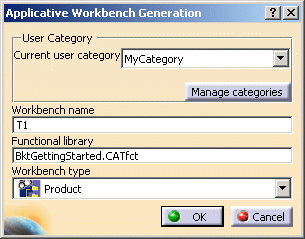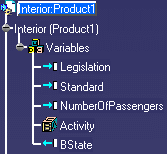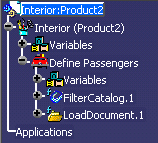 |
-
From the Start>Knowledgeware menu, access the
Business Process Knowledge Template workbench.
-
Create the Interior technological type.
-
Click the Create Technological Type
icon ( )
to create a type. The Create technological type dialog box is
displayed. )
to create a type. The Create technological type dialog box is
displayed.
-
Enter the name of the type: Interior.
-
Click OK to validate. For more
information about the technological types, see
Creating a Technological Object.
|
-
Add a Legislation attribute to the technological type.
- Click the Interior type in the specification tree
and click the Add Attribute icon (
 ).
The Add Attribute dialog box is displayed. ).
The Add Attribute dialog box is displayed.
- In the Name field, enter the name of the attribute:
Legislation.
- From the Type scrolling list, select String. The
attribute is an input of the technological type that will be
changed by the end-user (if need be).
- In the Value field, enter EEC.
- Click OK to validate. Double-click the Interior
type: Legislation now is displayed in the Attributes tab.
|
-
Add a Standard attribute to the technological type.
- Click the Interior type in the specification tree
and click the Add Attribute icon (
 ).
The Add Attribute dialog box is displayed. ).
The Add Attribute dialog box is displayed.
- In the Name field, enter the name of the attribute:
Standard.
- From the Type scrolling list, select String.
It is an input of the technological type that will be changed by
the end-user (if need be).
- In the Value field, enter SAE.
- Click OK to validate. Standard now is displayed in
the Attributes tab.
|
-
Add a NumberOfPassengers attribute to the
technological type.
- Click the Interior type in the specification tree
and click the Add Attribute icon (
 ).
The Add Attribute dialog box is displayed. ).
The Add Attribute dialog box is displayed.
- In the Name field, enter the name of the attribute:
NumberOfPassengers.
- From the Type scrolling list, select Integer. This
is an input of the technological object which enables the
end-user to modify it.
- In the Value field, enter 2.
|
-
Save your file (name it T1 for example) in the directory
specified by the environment variable CATGraphicPath of your V5
environment. For more information, see Setting
up the Working Environment.
Don't close your file.
-
Generate your workbench.
-
Click the Generate Applicative Workbench
icon ( ). ).
-
From the Current user category list,
select a category. For more information, see
Deploying
a User Workbench.
-
the Workbench name field of the
opening dialog box, enter the name of the workbench, T1 in this
scenario.
-
From the Workbench type scrolling
list, select Product.
-
Click OK to validate.
-
Click OK in the File Name
dialog box. A new application opens corresponding to the end-user
workbench.
|
 |
-
Instantiate the technological object and associate it
with the product.
- Click the root product in the specification tree to activate
your workbench.
- Select the icon associated with the type (if any) or select
the technological type check box in your workbench toolbar: You
can see the technological object and the product.
|
 |
The product is now extended by the data of the technological object. If
you open the F(x) editor, you will see the product parameters as well as
the technological object parameters. The product is typed Interior and
inherits from the behaviors of the technological type Interior that are
still to be defined.
-
Save your file.
Go back to BKT workbench to define the behaviors that you want to
associate with the technological type.
Define Passengers. The expert user wants the end-user to instantiate
data from a catalog depending on the standard, the legislation and the
manikin type (driver or passenger). The system instantiates the number of
instances specified by the user.
-
Click the Interior type and click the Sequential
Combination icon ( )
in the Structure toolbar. SequentialCombination is displayed in the
Behaviors View in the specification tree. )
in the Structure toolbar. SequentialCombination is displayed in the
Behaviors View in the specification tree.
-
Double-click SequentialCombination in the Behaviors
View, then double-click Interior in the Behaviors tab: The
SequentialCombination is now available.
-
Double-click the SequentialCombination in the
Behaviors tab. The Sequential Combination editor is displayed.
Use a Filtered Catalog to Select a Manikin
-
Click the Define passengers behavior in the Behaviors tab
and click the Filter Catalog behavior icon ( )
in the Doc based toolbar. )
in the Doc based toolbar.
-
Double-click the Filter Catalog behavior in the Behaviors
tab. The Filter Catalog editor is displayed.
- Click
 in
the Catalog document field to select the
BktManikins.catalog
file. in
the Catalog document field to select the
BktManikins.catalog
file.This catalog contains manikins matching the
US and the EEC legislations.
If the catalog is stored in the CATGraphicPath
directory, indicate only the name of the catalog, if not, enter
the whole path of the file.
-
Add attributes to specify the query that will
filter the catalog contents.
-
In the Filtering Keywords
field, click Add. The Attribute Window is
displayed.
-
In the Name field, enter
Name.
-
From the Type field scrolling
list, select String.
-
In the Value field, enter
SAE.
-
Click OK in the Attribute
Window.
|
- Add the Legislation parameter.
-
In the Filtering Keywords
field, click Add. The Attribute Window is
displayed.
-
In the Name field, enter
Legislation.
-
From the Type field scrolling
list, select String.
-
In the Value field, enter
EEC.
-
Click OK in the Attribute
Window.
|
|
For the catalog to reuse the same value as the one defined in the
technological object attributes, establish links between the parameters of
the behavior and the attributes of the technological object.
-
Expand the Filter Catalog node and right-click the Name
attribute, select Name object>Link to, expand the Interior
variables node and click the Standard attribute.
-
Right-click Legislation, select Legislation
object>Link To, expand the Interior variables node and click the
Legislation attribute.
Test the Filtered Catalog
-
Save your file and retest it. To do so, go back to the
user workbench.
-
Right-click Interior and select Interior (Product)
object> Define passengers. The Catalog Browser is displayed.
As you can see, the catalog was filtered: only the passengers matching
the EEC legislation are displayed.
-
Double-click one of the manikins. The manikin is still
not loaded.
-
Modify the Interior object attributes:
-
Right-click Interior and select Interior (Product)
object> Control_Define passengers.
-
Click OK when prompted to withdraw Define Passengers.
-
Right-click Interior and select Interior (Product)
object> Define passengers.
The Catalog Browser is displayed. As you can see, the catalog was again
filtered: only 2 manikins are available.
-
Close your product file.
Now go back to BKT to enable the end-user to load a manikin.
Load and Insert the Manikin
To load the manikin document into the current session, you need the Load
behavior.
-
Click the Define Passengers combination and click the
Load icon ( ).
LoadDocument is displayed in the Behaviors tab. ).
LoadDocument is displayed in the Behaviors tab.
-
Double-click the LoadDocument node in the Behaviors tab.
The Load Document editor is displayed.
-
Click the File path field, expand the FilterCatalog
variables node and select Chosen Path. It contains the path of the
document selected by the user in the Catalog Browser. Click OK
to validate.
 |
You have to define where the loaded part will be
inserted. In this example, we decide to insert the manikin under the
product on which the Define Passengers behavior is going to run.
This product does not exist yet, you must use the
bind mechanism, which is a way to
access the data using the specification tree.
For example, in the user workbench, if you want to find Interior
(Product.2) using the specification tree, ".." will enable you to
find Define Passengers, ../.. will enable you to find Interior, and
../../.. will enable you to find the extended product. |
-
Click the Define Passengers combination and click the
BindObject icon. BindObject is displayed in the Behaviors tab.
-
Double-click the BindObject node in the Behaviors tab.
The Bind Object editor is displayed.
Now you want to insert your product. To do so, you have to use the
Insert component behavior.
-
Click the Define Passengers combination and click the
Insert Components icon ( ).
InsertComponents is displayed in the Behaviors tab. ).
InsertComponents is displayed in the Behaviors tab.
-
Double-click the InsertComponents node in the Behaviors
tab. The Insert Components editor is displayed.
-
Expand the InsertComponents variables node, right-click
the Number attribute, select Number object>Link to, and select
the NumberOfPassengers attribute in the Interior variables node.
-
Save your file in the
\CATGraphicPath
directory and test it one last time. Click
here to display the final
.CATfct file (if you want to use it, open it and change the Filter
catalog file path).
-
From the Start menu, select the T1
workbench.
-
Select the root product and select the Interior
icon (if any) or check box. The Interior type is now associated with the
root product.
-
Right-click the Interior (Product1) object in the tree
and select Interior (Product1) object>Define Passengers. The
Catalog Browser opens. Note that the catalog is filtered according to
your settings: Legislation: EEC and Standard: SAE.
-
In the Catalog, double-click the BKTPassenger-2D-5-Female
manikin. The manikins are inserted. (Use the compass if the manikins
overlap to separate them.)
-
Expand the Interior (Product1) variables node.
-
Double-click the NumberOfPassengers attribute, set it to
1, and click OK to validate. One manikin is removed.
|
![]()